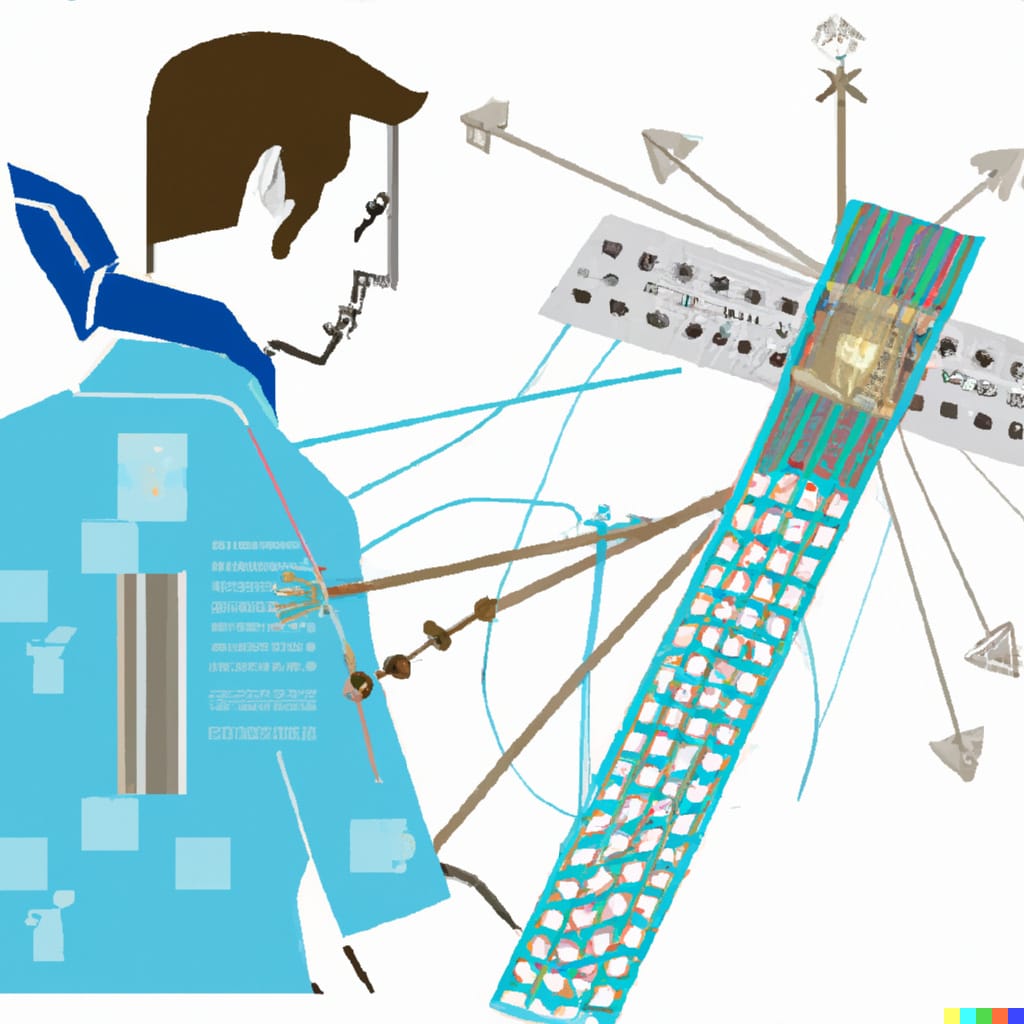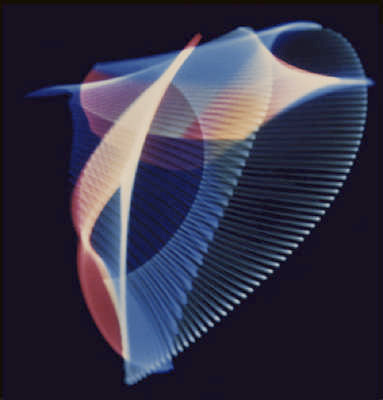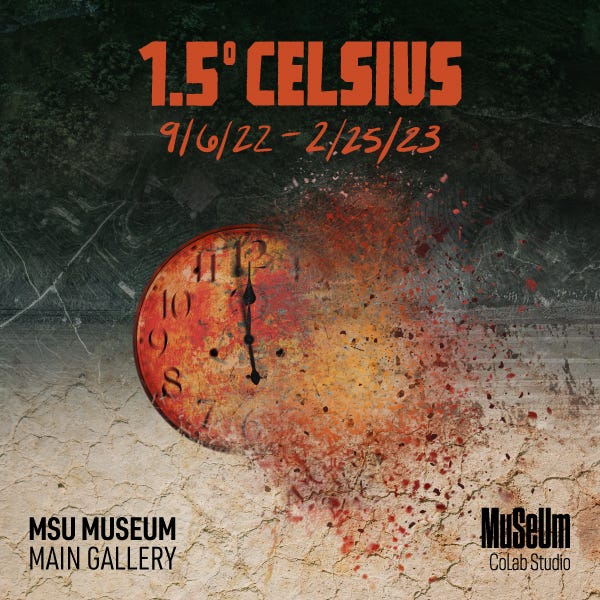Of Oscillons and Cybernetic Tortoises
Even Necktie Designers Can Use Electrons

In 1947, Popular Science Monthly published an article about the strange shapes produced by television test equipment, and suggested that industrial designers might turn to these abstractions for inspiration. Hence the title of the article: “Even Necktie Designers Can Use Electrons.”
In 1952, Ben Laposky found this article and went about using an oscilloscope and a long-exposure camera to document the movement of waves on the screen. Oscillons, the result of this experiment, is held up as an inspiration for computer art that would follow. The waves of the oscilloscope were captured onto the film negative and when they were developed, they looked something like this:

This makes Laposky a nominee for earliest documented screen shot, and certainly the godfather of the screen-saver industry that ultimately drained his images of uniqueness or expressive power. Time — and the disappearance of Windows 95 — has given us an opportunity to reassess Laposky’s work in a more contemporary context.
While art made with computers is an easier grab, calling Laposky’s work AI art is perhaps a stretch. But just as a good stretch makes our bodies more nimble, maybe we can learn something from trying this logical extension as a workout.
Let’s accept that:
a) it’s an image made by a machine for a screen
b) that screen is intended to output electronic information
c) the screen is outputting electronic information it assembled without human intervention
This might well be open to the claim that the work was “generated by an artificial intelligence.” If you scoff at that: buckle up. But first, let’s unpack a deeper question about Laposky’s work: nevermind an AI. Were they even generated by a computer?
To sort that out, we’ve got to look at what a computer is. The definition has changed over time and may change again. We’ll do the same thing with AI. So, let’s start stretching.
Oscilloscopic Abstractions
First off: The images were photographed from an oscilloscope. Oscilloscopes were (are) an electrical device that drew lines on a screen in response to changes in electrical voltage. They’d etch light into the screen through electrons. The most famous of these oscilloscopes is somewhere between the bleeping radars of submarine films and the display screen for heart monitors.
The way oscilloscopes worked in the 1950’s was, more or less, how an analog computer worked. Both took streams of electrical energy and converted them into information. Most analog computers were used to model physics or mathematical problems. As electrons went through an obstacle course, the behavior of that electrical energy would tell us certain things about the real world: whether a heart was beating, or a signal was bouncing back to us beneath the sea, or graphing calculus or geometry.
Laposky took those electrons and used them to model mathematical formulas. He also plugged them into various sine wave generators. Then he sat back and let the machines charge the screen.
He described the process this way, for a 1953 exhibition:
"Electronic Abstractions" are abstract art forms, traced by intricate electrical waves on the screen of a cathode ray oscilloscope. They are originated and fashioned by electronic circuits and displayed by the glowing beam of the electronic picture tube. While the elements which make up these creations are basically geometrical and mathematical, the resulting design forms are abstract in that they are not meant to depict any recognizable objects. They are compositions of electrical vibrations in light as pleasing to the eye as compositions of sound vibrations in music are pleasing to the ear. These beautiful visual rhythms and harmonies of electronic abstract art may be recorded by means of photography. The fifty pictures of abstractions in this exhibit are photographs-none were drawn by hand or made in any other way. All were composed as far as possible for design by the selection and control of the electronic instruments involved.”
Circuits responding to shifting electrical voltage is basically what computers did in 1952, and these images are depictions of that voltage in action. Voltage turned switches on or off, triggered gates to direct and redirect the electron charge. Laposky’s work shows the result rendered onto an oscilloscope, but the question gets foggy when you realize that no numbers are being calculated through digital means. What you’re looking at are electronic waves crashing into the rocky square-shaped shores: squares hitting sines in vibrant oscillations. Math gone wild. The most fundamental glitch.
These oscillations are controlled through the instruments producing these outputs. A sine wave generator produces a sine wave according to calculations; as you turn the knob the sine wave changes. The valleys and peaks rise or fall, the speed of crests changes, the whole structure, in combinations with others, reflects new patterns. It’s an algorithm, folks! So, there is some “computation” in the work. But it isn’t based on computational power. It’s the math of electricity that pins to real-world physics.
Definitions of computers are not stable. At one point it referred to people (usually women) doing math behind the scenes for engineers. Computers as machines existed alongside them, with such machines known as early as World War 2. But the word computer carried through as the world moved from analog to digital systems, without stopping to acknowledge that these machines were radically different in form, function, and capabilities.
So we can arguably call Ben Laposky’s works one of the earliest pieces of computer generated art using the framework of the time. But to do so means provoking a broader discussion about what a computer even is in the first place. Because if it is a computer-based artwork, and if, as Laposky says, the work is created without any interference aside from his own structure, then someone (more provocative than me) might argue that this is an early example of an artwork produced by Artificial Intelligence.
I’m not here to argue that. What I am here to argue is that our understanding of “artificial intelligence” is defined by cultural, social, and political contexts as much as the state of the art in technology. And so if we keep stretching, we might find something useful about our newfound limberness. Let’s reach even further.
AI is a Marketing Tool
A few definitions of AI:
- “Artificial intelligence is a computerized system that exhibits behavior that is commonly thought of as requiring intelligence.” (NSTC, 2016. Preparing for the Future of Artificial Intelligence.)
- “Artificial Intelligence is the science of making machines do things that would require intelligence if done by man.” (Raphael, B. 1976. The thinking computer.)
- “The science and engineering of making intelligent machines, especially intelligent computer programs.” (John McCarthy)
In summary, artificial intelligence is… artificially intelligent. Great! So we have a term that was loosely defined among academics of the era, and even less defined by the popular imagination.
Marketing rushes to a vacuum. Look around and you can find narrower definitions of AI coming out of tech companies these days.
- IBM: “artificial intelligence is a field, which combines computer science and robust datasets, to enable problem-solving.”
- Salesforce: “Artificial Intelligence (AI) is the concept of having machines “think like humans” — in other words, perform tasks like reasoning, planning, learning, and understanding language.”
- Google: “Artificial intelligence is a field of science concerned with building computers and machines that can reason, learn, and act in such a way that would normally require human intelligence or that involves data whose scale exceeds what humans can analyze.”
- Meta: “AI is an evolving field of computer science that's already part of daily life for billions of people around the world. It can take single tasks that are tedious and time-consuming for humans and then scale them up to benefit more people in more places.”
In summary: “artificial intelligence is whatever our product is.”
Take IBM, because it has the longest history of any of these companies. It has recently started narrowing the definition of AI to include training and knowledge acquisition, reflecting a data-centric conception of computers. But in the 1960s, IBM’s “Thinking Machines” were defined more by their computational power, because in the 1960s computational power is what IBM was selling. This short film suggested that a machine could think because it could analyze thousands of possible chess moves and choose the best one.
Today, we operate video games infinitely more complex than this system. In the video game industry, the AI is what moves zombies around in the cave, or a rival nation’s army competing for your land, because that is the product of a video game company.
Today, the dominant discourse of AI is that AI is data-driven and learns through computational power and modeling. By comparison, other approaches to artificial intelligence do not rely on data or computational power. Initially, the proto-AI researchers addressed artificial brans through the simple question of environmental awareness and responsiveness.
Ironically, one of these comes from an early pioneer of today’s neural networks. In 1948, W. Grey Walter’s Cybernetic Tortoises were an approach to artificial intelligence. They were exploring machines that could respond to the surrounding environment (see Andrew Pickering’s The Cybernetic Brain). The tortoise processed the presence or interruption of light.
Based on this definition of intelligence — and the idea that a machine’s purpose is what it does — then Laposky’s works are also defensible as the product of “artificial intelligence,” based on definitions of intelligent machines that existed in the day. They were tasked with making art, and they did.
Crucially, the images Laposky produced are not simply located in the screen, or in the machines producing sine or square waves. The image emerges from the relationship within the system: just as light is required to make a cybernetic tortoise move, oscilloscopes and sine wave generators are required for Laposky’s images. The art being produced is a result of the relationships that exist in its environment, just as the “intelligence” of the turtle emerges from the relationship between light sensor, light bulb, and motor. They are both cybernetically ‘intelligent’ machines, responding through sensors and displays. The intelligence emerges from the complex interchange of various components.
We can define AI through that cybernetic lens as an emergent property of objects in relationship to other objects, usually through the flow of circuits and signals. Or, we can define AI through a digital-centric lens, as we often do, limiting it to an emergent property of data and processing power. Your choice likely shapes your understanding of what AI art is, what it means to make it, and how we evaluate it.
The Artificially Intelligent Goal Post
Our definitions of “AI” are constantly moving. As systems get “smarter,” our demands on them grow, raising the bar for intelligence. These words are slippery in ways useful for marketing agencies and problematic when we start to prioritize one kind of intelligence over another.
The images generated by today’s GANs & Diffusion models (“AI generated”) come from a digital-centric view of AI. They are pulling from the study of a vast dataset, and then teaching itself that dataset by distilling information down to distinct relationships it finds in its own way. This is a specific kind of AI, a neural network. It can categorize relationships and then rearticulate those relationships on demand. Much of it is being touted as a new step forward, and it is: in terms of computational power and access to data, these systems are unprecedented.
But they aren’t the only approach to an artificially intelligent system. The relationship between today’s naturalized definition of artificial intelligence — as the result of data-driven, analysis-driven, computationally intensive processes — is cultivated by companies that make money off of data, analysis, and computational power.
Cybernetic intelligence, in contrast, is like growing your own tomatoes instead of buying them at WalMart. You can build analog machines at home using 1940’s technology. The question then isn’t “what counts as AI,” because that will always be a question of who has access to the power needed to train one. Instead, try asking what you need an AI to do, and why you must use data and server farms to accomplish that goal?
Laposky’s work reminds me that art is about making things with things. You have to navigate the components and assemble them, create something unique or visually compelling, and you have art. Sometimes those components are just ideas, sometimes they are ideas and objects, sometimes, they are just different objects and/or ideas in new arrangements. Laposky claimed the arrangements, not the output of those arrangements, and this is something AI artists using ready-made tools may need to address. You can do things with those images, perhaps, as part of your discovery of new arrangements. And perhaps you can use new arrangements of objects, and visualize them by the technologies you’re using. But producing an artwork using someone else’s assemblage will always be met with skepticism.
Imagine visiting Laposky’s studio in Cherokee, Iowa, in 1953, and looking through the camera. On the other end is an oscilloscope, pulsing with the output of television test equipment. You snap the shutter when the moment strikes. You’re uncertain of what you’ve captured until the film is developed. When the image comes out, could the image ever stop being Ben Laposky’s? Or perhaps it was never even his?
Things I Am Doing This Week

If you are near Michigan State University and keen to experience the mushroom music in person, the opening of the MSU Museum’s CoLab Studio show, 1.5 Degrees Celsius, is on September 9. The mushrooms are part of ‘Appetite for Deconstruction,’ an art-science research project supported the CoLab Studio (previously Science Gallery Detroit). The gallery piece is a sculpture with audio elements, and was created in collaboration with Claudia Westermann, Vinny Montag and researchers at the Xi'an Jiaotong-Liverpool University (XJTLU).
You can register for the opening here.
Thanks for reading!
Cybernetic Forests is a reader-supported publication. To receive new posts and support my work, consider becoming a free or paid subscriber.





